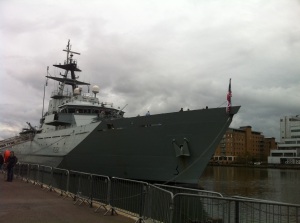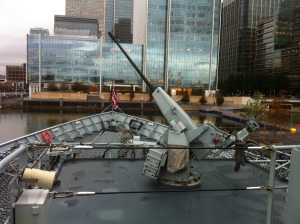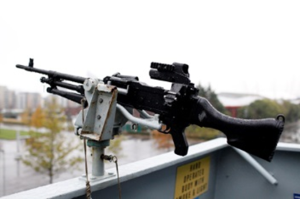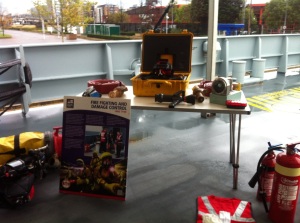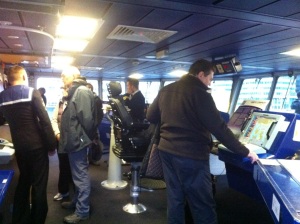HMS Tyne came to Canary Wharf for Remembrance Sunday. The Royal Navy vessel was docked on Tuesday, 5th November in the run up to Remembrance Day. On the 8th November, It was a unique opportunity for the GMI Maritime Security students to explore the vessel and to give you a glimpse of a Royal duty in UK waters. The HMS Tyne is a River-class patrol vessel, which was built in 2002 and was commissioned into the Royal Navy in 2003. Thousands of people took advantage of the unique opportunity to step on-board one of the most versatile and modern warships in the Royal Navy.
It arrived in Canary Wharf at around 3pm, navigating West India Dock – with around four metres to spare each side while battling the Thames currents – to berth at Wood Wharf. Lieutenant Commander Robert Laverty, HMS Tyne’s Commanding Officer. “It is always a privilege to visit London but it’s a particular honour to be able to play a full part in London Poppy Day and the Remembrance Day Services, giving my crew a chance to help raise money for this important cause, while remembering the ultimate price paid by many of our fellow servicemen and women.”
The bridge is the main control console of the vessel, which can maintain navigation with just two people on the watch-keeping. The 79.9 meters long vessel with a displacement of 1677 tonnes can attain a maximum speed of 20 knots, with a range of 5000+ nautical miles (3 ½ times round the UK Mainland by sea). The 10-year-old ship, one of the busiest in Royal Navy fleet operating on average nine out of every 10 days, has a crew of 45 on the books with around 30 on-board at one time.
The weapon engineering department provides commands with the weapons, communication equipment and sensors that enable the ship to fulfil its operational tasks. HMS Tyne has been installed with a 20mm Gambo Gun, which is a fast reaction, high velocity and high rate of fire weapon, which does not require any external power supplies. It can fire up to 900 rounds per minute with a range of 1100 yards in an anti-aircraft role and 1300 yards in surface mode.
The 5.56 mm SA80A2 rifle is the British Armed Forces standard personal weapon, having an effective range of between 300m and 600m firing and a rate of fire of 700 to 800 rounds per minute. It can be fired in single or automatic modes and is used to protect the ship against close range threats.
Two 7.62mm General Purpose Machine Guns (GPMG) are mounted on each bridge Wing, these are gas and spring operated weapons which can be used as a personal weapons or as a part of ship’s fixed armament . These can also fire 900 rounds per minute with a range of over 900 yards.
Whilst on-board, the Maritime Security students from GMI and other visitors were able to tour the vessel, looking at the bridge, fire-fighting equipment and weaponry whilst learning about her capabilities and the important role that the RN performs at sea every day.
The ship, which is one of three patrolling estuaries around Britain, does not support the landing of an aircraft, instead does have space for winching from helicopters on deck and is regularly used for training. Many life rafts are installed on board the vessel, each one may able to keep afloat 50 people in case of any emergency situation arises, for instance abandon ship. The river-class offshore patrol ship HMS Tyne was built in Southampton to safeguard fishing stocks in the UK and her main role is to enforce national and EU fisheries legislation. She also operates in areas of environmental protection, search and rescue and maritime security.
This was my first visit to a patrolling vessel of Royal Navy in UK and I was mesmerised by the weapon engineering on-board the vessel and its active role towards the marine environment protection.
Akash Raj
MSc Maritime Security Student
Greenwich Maritime Institute
